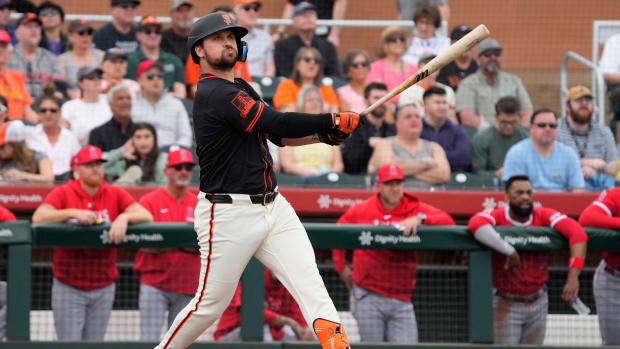
Mike Trout: What is he really worth?
Through his first two seasons with the Angels, Mike Trout has already produced over 20 WAR. (Jeff Gross/Getty Images)
You have reached your limit of 4 premium articles
Register your email to get 1 more
While the Braves have led the way in making headlines via the long-term extensions they've hammered out with their top young players, the industry's biggest potential extension of them all is looming. According to Mike DiGiovanna of the Los Angeles Times, the Angels are reportedly in discussions with Mike Trout involving a contract in the range of six years and $150 million. The scary thing is that he's probably worth far more than that.
In his first two full major-league seasons, Trout has more or less broken the scale by which we evaluate the performance of young players. After hitting .326/.399/.564 with 30 homers and 49 steals en route to a staggering 10.9 Wins Above Replacement in 2012 (Baseball-Reference.com version), he followed up by batting .323/.432/.557 with 27 homers and 33 steals in 2013, a performance worth 9.2 WAR. His decline in value rests entirely on the estimates of his glovework; via Defensive Runs Saved, he dipped from 21 runs above average in 2012 to nine runs below in 2013, though via Ultimate Zone Rating, the drop was more gentle, from 13.3 to 4.4. Using those latter figures, FanGraphs' version of WAR shows him with seasons of 10.0 and 10.4 WAR.
No matter which model you use, that's two monster years under the belt of player who turned 22 last August. Using B-Ref's WAR model, Trout's 20.8 WAR through his age-21 season is the highest for any position player in history, outdoing Mel Ott's 17.9 and Ty Cobb's 15.7. His 10.9 was a record for a 20-year-old, while his 9.2 as a 21-year-old trailed only Rogers Hornsby's 9.9-WAR 1917 season among players of that age. In both years, his WAR led the majors, an accomplishment that nonetheless went unrewarded by AL MVP voters, who gave the award to Tigers slugger Miguel Cabrera in both seasons.
Though Trout is still a year away from arbitration eligibility, he's about to get rewarded anyway, if only because the Angels have to lock in some cost certainty. When that happens, it will almost certainly bust the standard set for players with less than three years of service time, a mark held by Buster Posey's eight-year, $167 million extension ($18.56 million average annual value). Because of the way contracts that buy out arbitration years tend to escalate, it may well set a record for single-season salary during what would be his free-agent years (the last two of a six-year deal), topping the $30 million or even $33 million that Clayton Kershaw is set to earn at various points during the seven-year, $215 million contract he signed in January.
To get a better idea of what Trout could be worth, we can dust off the model I used in connection with the winter's top free agents such as Robinson Cano, Jacoby Ellsbury and Shin-Soo Choo, one incorporating past performance, a projection of future performance, the market cost of a marginal win, inflation and aging, building on the top research done in those areas. As I noted in that series, rather than pin a single value to a player, the goal was to show how changes in our assumptions with regards to any of those parameters can affect an estimate of worth, thus producing a range that may or may not be in line with the rumors floating around.
Because his 2011 debut season consisted of only 40 games and 135 plate appearances, Trout doesn't have a long enough track record to use a weighted three-year sample to create a baseline projection for 2015 as I did for those aforementioned free agents. So we'll have to fudge it. If I use 2.0 WAR for that age 19 season, suggesting that he would have been a more or less league-average player, a 5/4/3 weighting — as used by Tom Tango in his deliberately rudimentary Marcel projection system (so simple even a monkey could calculate it) — produces a 2015 estimate of 8.0 WAR.
For a free-agent hitter in his late 20s or early 30s, I would take that baseline estimate and project annual declines of around three to five runs per year going forward. The crazy thing in this case, however, is that Trout's age suggests he can still improve. The research Jeff Zimmerman did at FanGraphs shows that great players in their early 20s tend to improve by about five runs per year until about age 25, then maintain that level through about age 29 before beginning a gradual decline. If we start with that 8.0 WAR baseline, that would push Trout back up to 8.5 WAR for 2015, 9.0 for 2016 and 9.5 for 2017, his age-25 season — mind-boggling values in this case.
For the sake of modeling, let's stick with that 9.5 WAR plateau. For the value of a win, I'll use Dan Szymborski's estimate of $5.45 million based upon this year's free-agent market, and I'll assume 3.3 percent annual inflation — the increase of that figure from the $5.276 million per win I pulled from Russell Carlton's research in that series. Hold onto your hats:
Year | Age | WAR | Market $/W | Prod $M |
2014 | 22 | 8.0 | 5.45 | $43.6M |
2015 | 23 | 8.5 | 5.63 | $47.9M |
2016 | 24 | 9.0 | 5.82 | $52.3M |
2017 | 25 | 9.5 | 6.01 | $57.1M |
2018 | 26 | 9.5 | 6.21 | $59.0M |
2019 | 27 | 9.5 | 6.41 | $60.9M |
Total |
| 54.0 |
| $320.7M |
Even if he dips to 8.0 WAR in 2014, the free agent market value of Trout's performance figures to be worth more than $43 million, and to climb upwards above $60 million. For the six years in question, that adds up to 54.0 WAR and $320.7 million worth of performance, all for the very reasonable average price of $5.94 million per win.
Before I begin chipping away at those breathtaking values, it's worth noting that arbitration-eligible players don't make anything near full value for their services; those team-controlled years come at a considerable discount. The most commonly cited model, which dates back to research done a few years ago by Tango is the 40/60/80 rule: first-year arbitration eligibles earn about 40 percent of what a comparable free agent would earn, with second-year eligibles jumping to 60 percent and third-year eligibles to 80 percent. Standard-setting players such as Kershaw and Trout are the ones who tend to break the 40/60/80 rule, but as a framework, it will do here.
That rule doesn't affect the actual expectations for Trout's production, but it does affect what he can reasonably be expected to receive for his services before he reaches free agency. If we discount the first three years of Trout's production at those rates, the estimates become $17.4 million for 2014, $28.7 million for 2015 and $41.9 million for 2016, lowering the total valuation to $265 million, and the cost per win to $4.89 million.
That model projects Trout to produce 74.8 WAR through his age-27 season, which again would be a record. Historically speaking, the highest WAR figures through that age have been set by Cobb (68.8) and Mickey Mantle (67.4). In light of that, it's probably worth tamping down the projection above so that it falls in line. If I simply pencil in a flat 8.0 WAR per year from 2014-19, Trout's WAR through age-27 ties Cobb's at 68.8. The full market value of that production drops from $320.7 million to $284.2 million, while the arbitration-year discounts bump that down to $230.7 million.
As you can see, there's quite a wide gulf between the $150 million figure that DiGiovanna is reporting and the $230 million produced by my model. If I work backward to reach a discounted value of $150 million while maintaining my other assumptions regarding inflation, the cost of a win and the compensation ratio for arbitration years, the implication is that Trout would average 5.2 WAR per year for the six years in question. Changing the inflation estimate back to the more commonly cited five percent, which I generally stuck with in my free agent models, lowers the presumed average WAR per year for the 2014-19 period to 4.95; either way, that's around half of Trout's actual value in each of his first two full seasons.
All of which is to suggest that if a long-term deal with the Angels comes about in the near future, whatever figure Trout and agent Craig Landis agree to is almost certainly underselling him based on his brief but astronomical track record; perhaps Landis should be asking the franchise for chunks of California real estate or intellectual property rights to Disney characters.



































